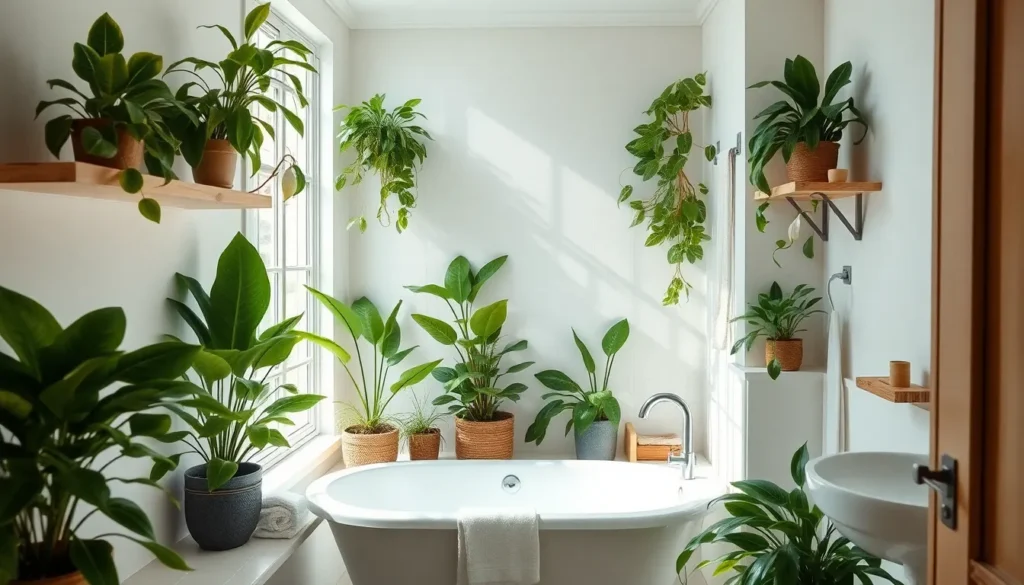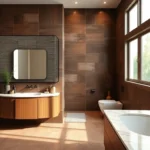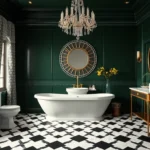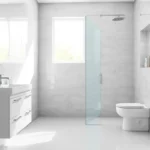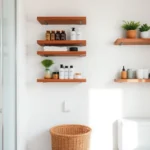Transforming your bathroom into a lush green sanctuary isn’t just a trend—it’s a game-changer for your daily routine. We’ve discovered that adding plants to your bathroom creates an instant spa-like atmosphere while naturally purifying the air and boosting humidity levels that benefit both you and your leafy companions.
The unique environment of bathrooms, with their high humidity and varying light conditions, actually makes them perfect homes for exact plant varieties. Many homeowners overlook this incredible opportunity to create a stunning botanical retreat in one of their most-used spaces.
We’re about to share the most effective bathroom plant ideas that’ll turn your ordinary washroom into an extraordinary oasis. From low-light champions that thrive in windowless bathrooms to moisture-loving beauties that flourish near your shower, you’ll discover exactly which plants work best and how to arrange them for maximum visual impact.
Snake Plants: The Ultimate Low-Maintenance Bathroom Companion
Snake plants stand out as the perfect addition to your bathroom sanctuary, offering exceptional resilience and striking visual appeal with minimal effort required.
Perfect for Dim Lighting Conditions
Snake plants excel in low light environments that characterize most bathrooms. These hardy specimens can survive and even flourish in bathrooms with small windows or no natural light at all. We’ve found that snake plants maintain their vibrant green coloration and distinctive yellow edges even when placed in corners far from light sources.
Artificial lighting from standard bathroom fixtures provides sufficient illumination for these adaptable plants. They won’t stretch or lose their compact form like many other houseplants do when deprived of bright light. This makes them ideal for windowless powder rooms, guest bathrooms, or any space where natural light is limited.
Thrives in High Humidity Environments
Bathroom humidity levels ranging from 40% to 60% create optimal growing conditions for snake plants. Steam from hot showers provides the moisture these plants naturally enjoy without requiring additional misting or humidity trays. We recommend placing them near but not directly in the shower spray zone to maximize benefits.
These plants actually perform better in humid bathroom environments compared to dry living spaces. Their thick, waxy leaves efficiently absorb moisture from the air, helping them maintain their lush appearance year round. This natural humidity regulation also supports the plant’s air purifying capabilities.
Requires Minimal Watering and Care
Snake plants need watering only every 2 to 4 weeks, making them perfect for busy schedules or frequent travelers. We suggest checking the soil moisture by inserting your finger 2 inches deep before watering. Overwatering poses more risk than underwatering for these drought tolerant plants.
Basic care involves wiping leaves monthly with a damp cloth to remove dust and maintain their glossy appearance. These plants rarely require repotting, often thriving in the same container for 3 to 5 years. Pruning is unnecessary unless you want to remove damaged leaves or control height growth.
Pothos: The Trailing Beauty That Loves Bathroom Steam
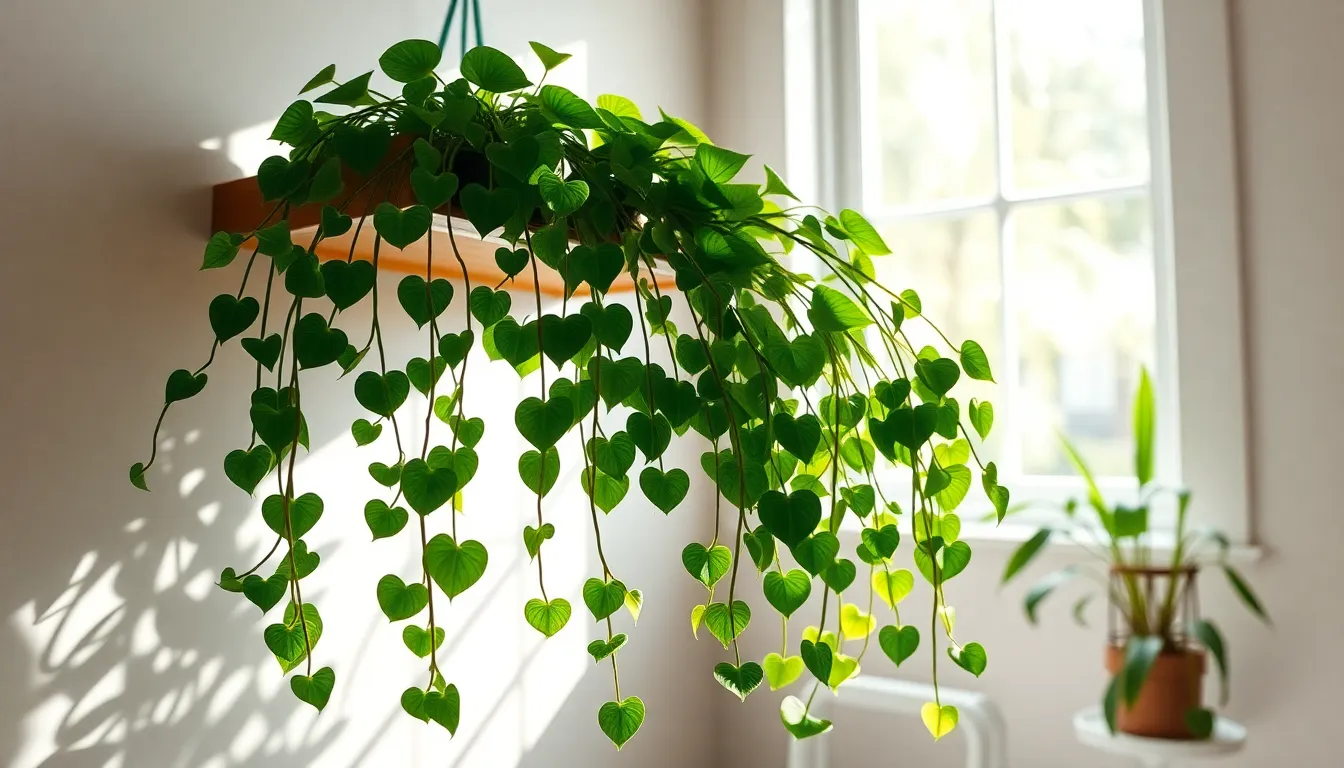
While snake plants excel in low light situations, pothos brings ever-changing visual movement to your bathroom with its cascading vines and heart-shaped leaves.
Cascades Beautifully from Shelves and Windowsills
Pothos creates stunning visual displays when positioned on bathroom shelves or windowsills where its trailing vines can flow naturally downward. The plant’s versatile growth pattern allows it to adapt to various bathroom layouts, whether you place it on a high shelf above your bathtub or position it near a window for gentle natural light.
We love how pothos vines can extend several feet in length, creating living curtains that add depth and texture to your bathroom space. The plant’s ability to trail makes it perfect for filling empty corners or softening hard bathroom edges with organic shapes.
Grows Rapidly in Humid Conditions
Bathroom steam provides the ideal environment for pothos to thrive and expand quickly throughout your space. The plant’s rapid growth rate means you’ll notice new leaves appearing regularly, especially during the humid months when shower steam creates consistent moisture levels.
We’ve observed that pothos responds exceptionally well to the high humidity conditions found in most bathrooms, often growing faster than in other rooms of the house. The consistent moisture from daily showers eliminates the need for frequent misting, making bathroom care even simpler.
Easy Propagation for Expanding Your Collection
Pothos offers one of the simplest propagation methods among houseplants, allowing you to create multiple plants from a single parent. Simply cut a vine section with at least one node, place it in water, and watch roots develop within weeks.
We recommend propagating pothos cuttings directly in small bathroom containers filled with water, creating attractive displays while new roots form. Once roots reach 2-3 inches long, you can plant them in soil to establish new pothos plants throughout your bathroom or share them with friends who want to start their own bathroom plant collections.
Peace Lilies: Elegant Blooms That Filter Bathroom Air
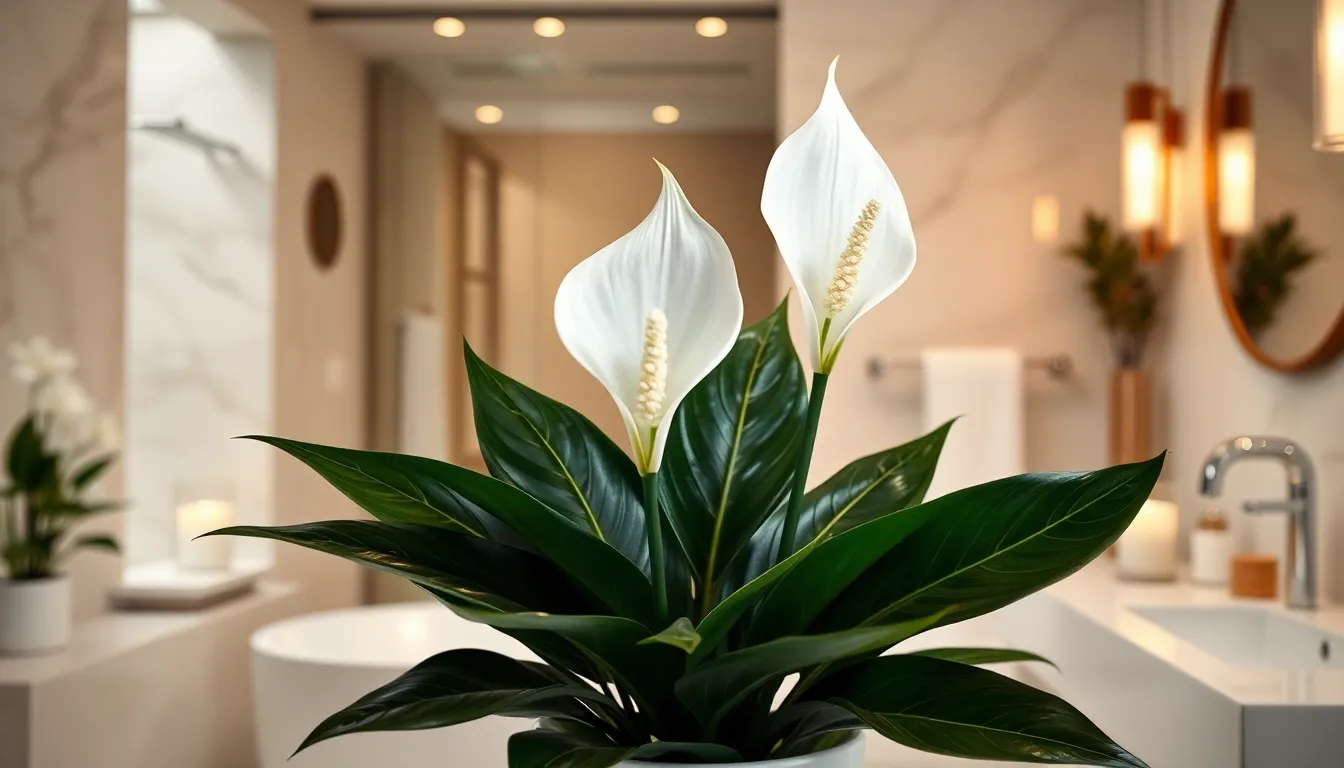
Moving beyond the trailing beauty of pothos, we find another exceptional bathroom plant that combines stunning visual appeal with powerful air cleaning capabilities.
Produces Beautiful White Flowers
Peace lilies create an elegant focal point in any bathroom with their distinctive white blooms that emerge from dark green foliage. These sophisticated flowers add a touch of luxury to your space while maintaining the plant’s reputation for easy care. The striking contrast between the pristine white petals and lush green leaves transforms even the most mundane bathroom into a spa-like retreat. We particularly love how these blooms brighten dim bathroom corners where other flowering plants might struggle to thrive.
Excellent Natural Air Purifier
Filtering out formaldehyde, benzene, and trichloroethylene from your bathroom air makes peace lilies exceptional additions to your indoor plant collection. These plants excel at removing common household pollutants that often accumulate in enclosed bathroom spaces. Their natural ability to process toxins while releasing clean oxygen creates a healthier environment for your daily routines. We’ve found that peace lilies work particularly well in bathrooms because they actually benefit from the humid conditions created by showers and baths, absorbing excess moisture while purifying the air simultaneously.
Indicates Watering Needs Through Drooping Leaves
Drooping leaves serve as a clear visual indicator when your peace lily needs water, eliminating the guesswork involved in plant care. This natural communication system prevents both overwatering and underwatering, two common mistakes that can harm bathroom plants. Peace lilies prefer consistently moist soil but can tolerate the low light conditions typical of most bathrooms without losing their vitality. We appreciate how this built-in watering reminder makes peace lilies perfect for busy homeowners who want beautiful plants without constant maintenance worry.
ZZ Plants: The Glossy Green Addition for Busy Bathrooms
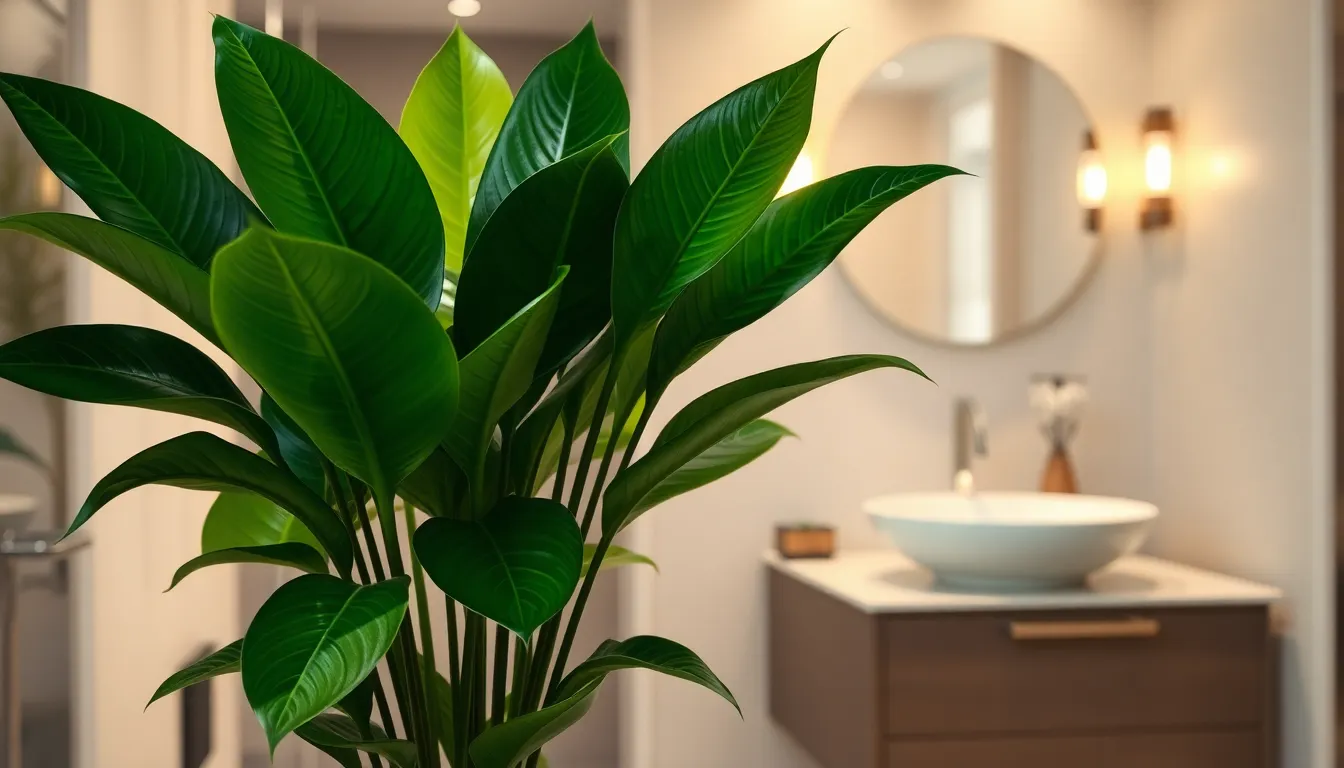
ZZ Plants (Zamioculcas zamiifolia) stand out as one of the most resilient bathroom plant options for homeowners with demanding schedules. These remarkable plants combine stunning visual appeal with unmatched durability.
Tolerates Neglect and Irregular Watering
ZZ Plants excel in busy bathrooms because they’re extremely tolerant of neglect and can survive extended periods without attention. We love how these plants store water in their thick stems and roots, allowing them to thrive even when you forget to water them for weeks. Their drought tolerance makes them perfect for people who travel frequently or have unpredictable schedules.
Irregular watering schedules won’t phase these hardy plants, as they actually prefer to dry out completely between waterings. We recommend checking the soil moisture only when you remember, rather than setting strict watering routines. ZZ Plants can survive in conditions where other bathroom plants would quickly deteriorate, making them nearly impossible to kill through neglect.
Stunning Waxy Foliage Adds Visual Appeal
Glossy, waxy foliage creates important visual impact in any bathroom setting, transforming plain spaces into elegant retreats. We appreciate how the thick, shiny leaves reflect light beautifully, adding brightness to dimmer bathroom corners. Each leaf displays a rich, deep green color that maintains its vibrancy regardless of bathroom conditions.
The architectural structure of ZZ Plant branches creates natural focal points that complement modern bathroom designs. We find their upright growth habit particularly striking when placed near vanities or in floor planters. These plants add sophisticated texture without overwhelming smaller bathroom spaces, making them ideal for apartments and compact homes.
Adapts Well to Various Light Levels
Light adaptability makes ZZ Plants suitable for bathrooms with different window configurations and natural light availability. We’ve observed these plants thriving in conditions ranging from low light to indirect bright light, maintaining their health and appearance regardless of placement. They perform exceptionally well in windowless bathrooms that rely solely on artificial lighting.
Fluorescent bathroom lighting provides sufficient illumination for healthy ZZ Plant growth, eliminating concerns about inadequate natural light. We recommend positioning them anywhere in your bathroom where they won’t be disturbed, as they’ll adapt to whatever light conditions exist. Their flexibility allows you to relocate them as needed without worrying about light shock or adjustment periods.
Spider Plants: The Family-Friendly Option for Bathroom Shelves
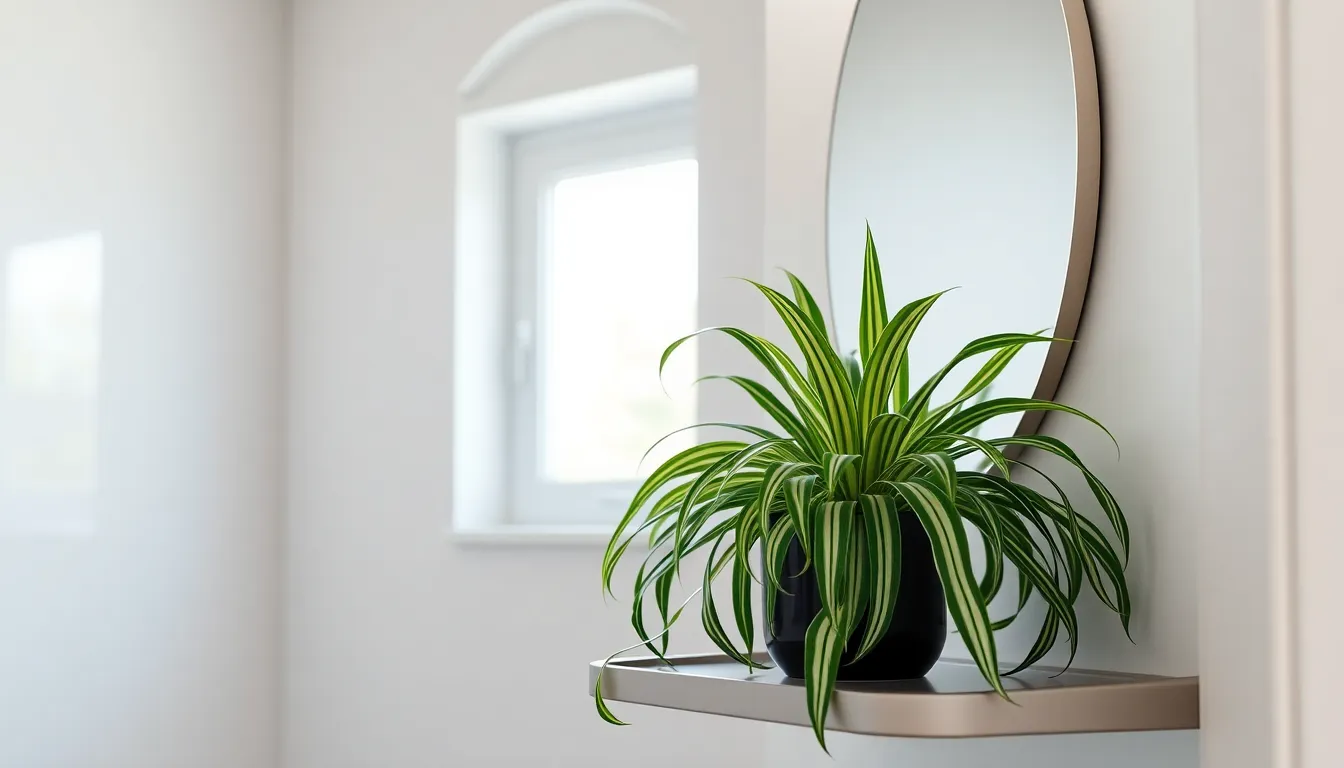
We’ve found that spider plants offer the perfect combination of beauty and safety for households with pets and children. These remarkable plants create stunning displays while maintaining their reputation as one of the most reliable bathroom companions.
Safe for Pets and Children
Spider plants earn our top recommendation for family bathrooms because they’re completely non-toxic to both pets and children. We can place these plants anywhere in our bathroom without worrying about curious cats nibbling on leaves or toddlers exploring their greenery. Their safety rating makes them ideal for busy households where supervision isn’t always possible.
Pet owners particularly appreciate how spider plants provide all the benefits of bathroom greenery without the anxiety of potential poisoning. Children can help care for these plants as part of their learning experience, making them excellent educational tools for teaching responsibility and plant care basics.
Produces Charming Baby Plants
Spider plants create one of nature’s most delightful surprises through their production of baby plants, also known as plantlets or spiderettes. We love how these miniature versions dangle gracefully from the mother plant on long, arching stems, creating natural cascading displays perfect for bathroom shelves.
These baby plants develop roots while still attached to the parent, making propagation incredibly simple for beginners. We can easily snip off mature plantlets and place them in water or soil to create new plants, allowing us to expand our bathroom garden collection or share with friends and family.
The continuous production of baby plants means our spider plant display constantly evolves and grows, providing ongoing visual interest and natural movement in our bathroom space.
Thrives in Bathroom’s Natural Humidity
Spider plants absolutely flourish in the humid conditions that bathrooms naturally provide. We’ve observed how these plants respond positively to the steam and moisture generated by daily showers, developing lush, vibrant foliage that stays healthy year-round.
Their ability to thrive in humidity makes them perfect for bathrooms where other plants might struggle with moisture-related issues. We can grow spider plants successfully in low-light bathroom conditions, as they adapt well to the filtered light that most bathrooms receive.
The combination of humidity tolerance and low-light adaptability means we can position spider plants virtually anywhere in our bathroom, from windowsills to corner shelves, without compromising their health or growth potential.
Aloe Vera: The Functional Plant That Doubles as First Aid
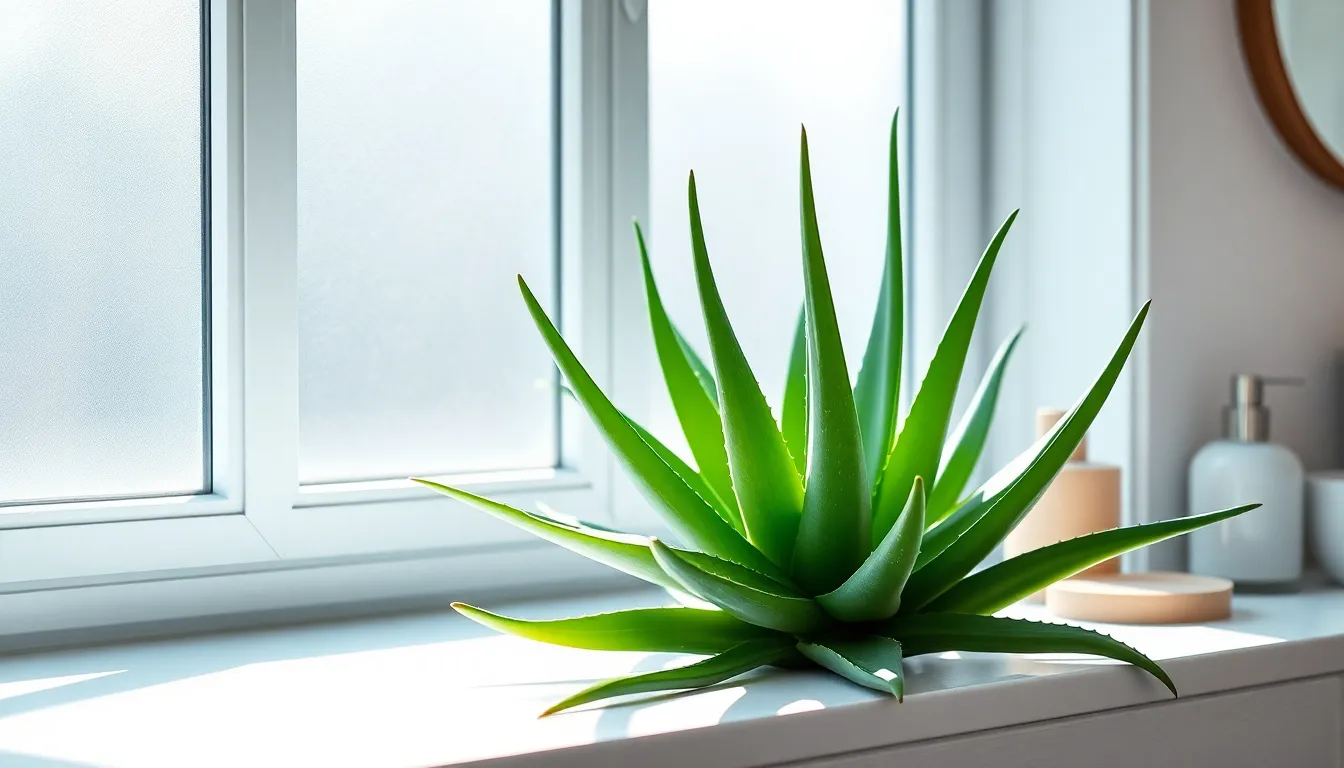
Aloe vera stands out among bathroom plants because it combines decorative appeal with practical healing benefits. This remarkable succulent transforms your bathroom into both a green sanctuary and a natural medicine cabinet.
Provides Natural Healing Properties
Aloe vera’s healing gel offers immediate relief for common skin irritations like burns, cuts, and sunburn. Fresh gel from the plant’s leaves provides superior potency compared to store-bought alternatives, giving you instant access to natural treatment right in your bathroom. Breaking open a leaf releases cooling gel that soothes razor burns, minor cuts from shaving, and dry skin conditions common in bathroom environments.
The plant’s natural antibacterial and anti-inflammatory compounds make it perfect for post-shower skin care routines. Having aloe vera within reach means you’ll never run out of this gentle, effective remedy when you need it most. Simply snap off a small section of leaf and apply the clear gel directly to affected skin for immediate comfort.
Stores Water in Thick Succulent Leaves
Aloe vera’s thick, fleshy leaves act as natural water reservoirs, making this plant incredibly drought-tolerant and low-maintenance. These succulent leaves store moisture efficiently, allowing the plant to survive extended periods without watering even in bathroom environments. You’ll notice the leaves become slightly thinner when the plant needs water and plump up again after a thorough drink.
This water storage system makes aloe vera perfect for busy households where consistent plant care might be challenging. The plant’s ability to regulate its own moisture levels means you can water it infrequently without worrying about overwatering, which is often more harmful than underwatering for succulents.
Prefers Bright Indirect Bathroom Light
Aloe vera thrives in bright, indirect sunlight, making it ideal for bathrooms with windows or good natural light exposure. Direct sunlight can actually harm the plant by causing leaf burn, so positioning it near a frosted window or in a well-lit area away from harsh rays creates optimal growing conditions. The plant’s leaves will maintain their vibrant green color and sturdy structure when provided with adequate indirect lighting.
Bathrooms with skylights or large windows offer perfect environments for aloe vera growth. If your bathroom lacks natural light, consider rotating the plant with others in brighter areas of your home to maintain its health and medicinal potency. The plant will signal its lighting needs through leaf color changes, with pale or yellowing leaves indicating insufficient light exposure.
Boston Ferns: The Lush Statement Piece for Spa-Like Ambiance
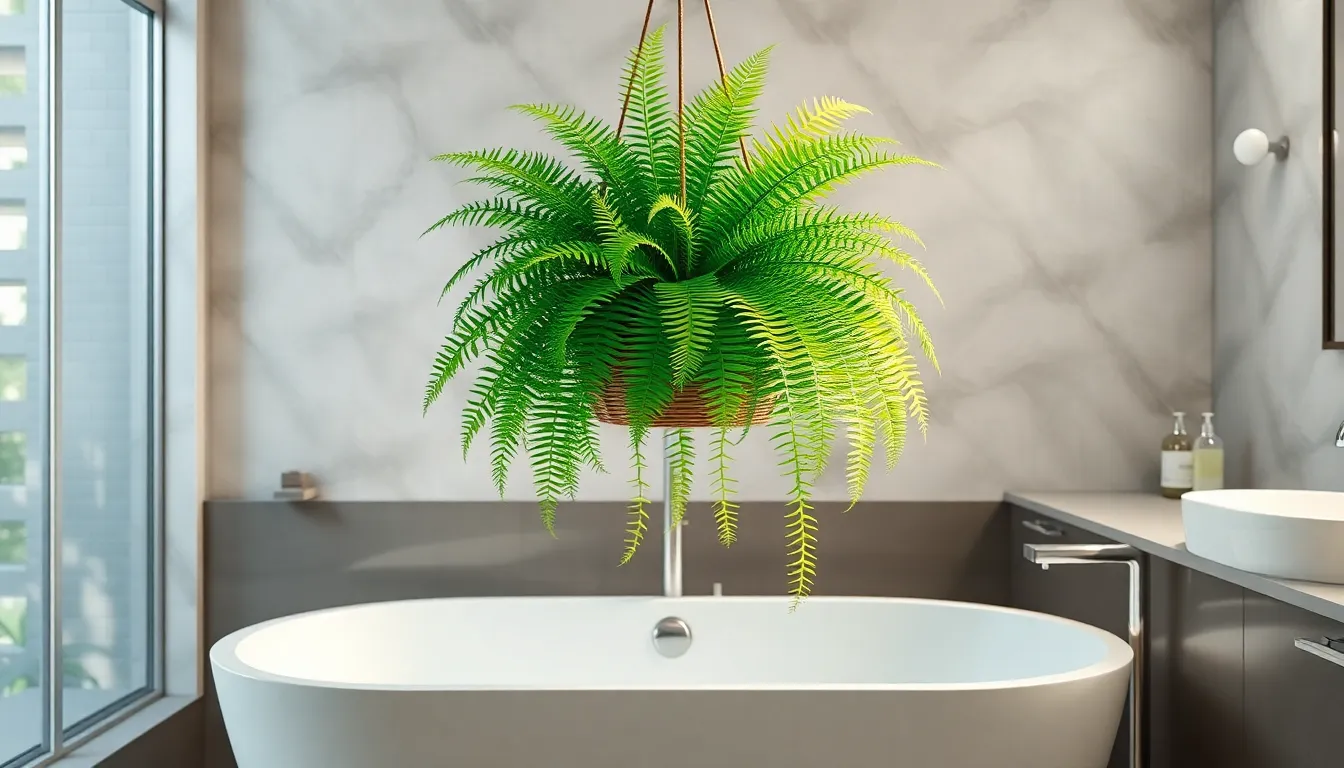
Boston ferns bring an impressive tropical elegance to your bathroom with their vibrant green fronds that instantly transform any space into a luxurious retreat.
Creates Dramatic Cascading Effect
Boston ferns produce stunning cascading fronds that create an impressive visual impact when displayed properly in bathroom spaces. Their vibrant green foliage naturally drapes downward, adding depth and movement to your decor while softening harsh angles and corners. Positioning these plants on high shelves allows their elegant fronds to flow gracefully, creating natural curtains that enhance your bathroom’s spa-like atmosphere. The cascading effect becomes even more pronounced as the plant matures, with fronds reaching impressive lengths that draw the eye upward and make your ceiling appear higher.
Loves High Humidity and Frequent Misting
Boston ferns thrive exceptionally well in the high humidity environments that bathrooms naturally provide through daily showers and baths. These moisture-loving plants prefer consistent humidity levels, making them perfectly suited for steamy bathroom conditions that would stress other houseplants. Regular misting becomes effortless in bathroom settings where you can easily spray their fronds during your daily routine. The natural steam from your shower provides additional moisture that Boston ferns crave, eliminating the need for artificial humidifiers or complex care routines.
Perfect for Hanging Baskets Above Bathtubs
Hanging baskets positioned above bathtubs create the ideal display method for Boston ferns while maximizing your bathroom’s vertical space. These elevated placements allow the ferns’ cascading fronds to create a natural canopy effect that enhances your bathing experience with lush greenery overhead. The steam rising from your bathtub provides direct humidity benefits to overhead Boston ferns, creating perfect growing conditions without additional effort. Installing hanging baskets above bathtubs also keeps these plants safely away from foot traffic while ensuring they receive adequate natural or artificial lighting from bathroom fixtures.
Bamboo: The Zen-Inspired Addition for Modern Bathrooms
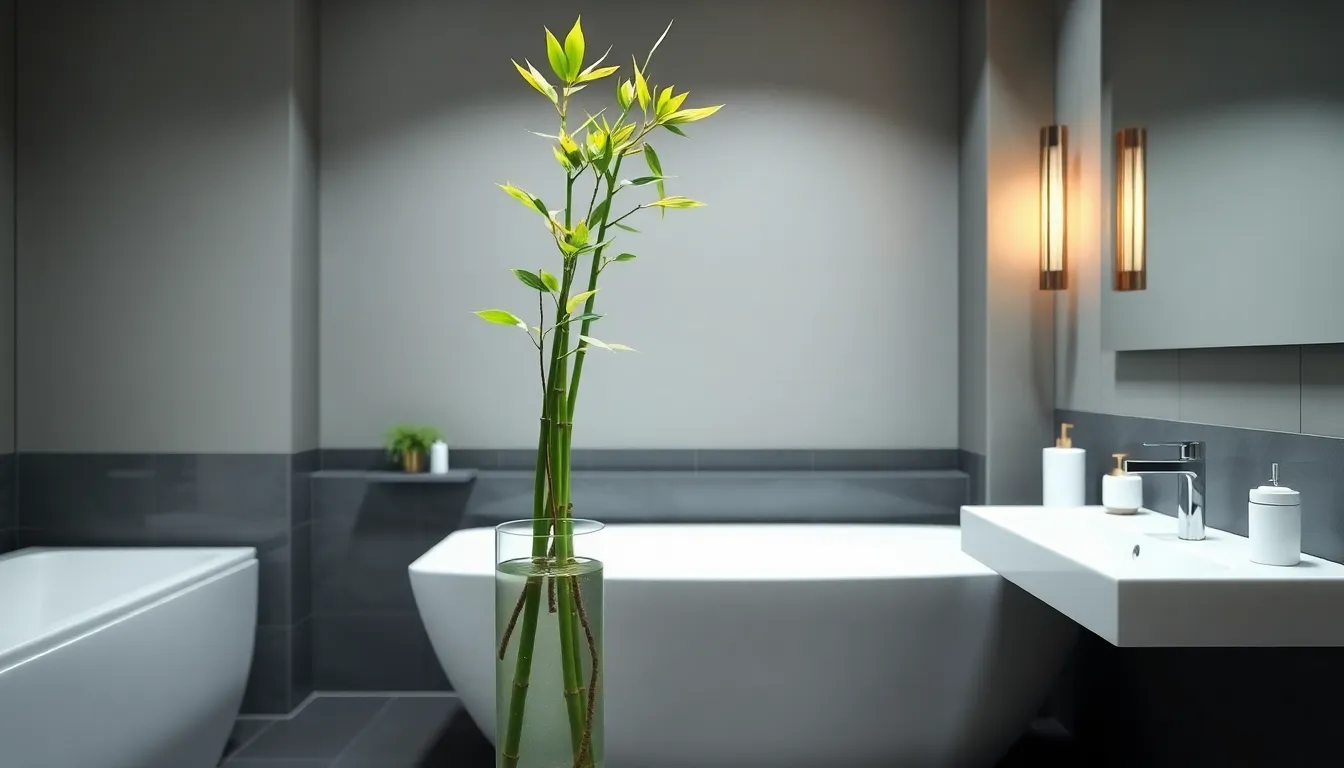
We’ve discovered that bamboo offers a unique blend of simplicity and elegance that transforms any bathroom into a peaceful retreat. This versatile plant brings the calming essence of spa environments directly into your home.
Grows Well in Water-Filled Containers
Bamboo thrives beautifully in water-filled containers, making it perfect for bathrooms with limited soil space. We love how this eliminates the mess of traditional potting soil while providing a clean, modern look. The plant’s roots develop naturally in water, creating an attractive display as they grow and spread throughout the container.
Most lucky bamboo varieties flourish in just 1 to 3 inches of water, requiring no complex growing medium. We recommend using distilled or filtered water to prevent mineral buildup that can harm the plant. The transparency of glass containers allows you to monitor water levels easily while showcasing the elegant root system as it develops.
Adds Asian-Inspired Aesthetic Appeal
Bamboo instantly creates a Zen ambiance that promotes relaxation and mindfulness during your daily routines. We appreciate how its clean lines and vertical growth pattern complement modern bathroom designs while adding natural texture. The plant’s slender stalks and bright green leaves create visual interest without overwhelming smaller spaces.
Traditional feng shui principles suggest that bamboo brings positive energy and good fortune to living spaces. We find that arranging multiple stalks in odd numbers enhances the aesthetic appeal while following these ancient design principles. The minimalist beauty of bamboo stems creates striking focal points whether displayed on countertops, floating shelves, or windowsills.
Requires Minimal Maintenance and Space
Bamboo demands remarkably little attention, making it ideal for busy households and small bathroom spaces. We change the water every 2 to 3 weeks, ensuring the plant stays healthy without constant monitoring. The compact growth habit means you can enjoy lush greenery even in tight quarters around sinks or toilet areas.
Most bamboo varieties adapt well to low-light conditions typical of many bathrooms, requiring no special lighting arrangements. We simply wipe the leaves occasionally to remove dust and maintain their glossy appearance. The plant’s slow growth rate means you won’t need frequent pruning or repotting, making it perfect for maintaining that serene, uncluttered bathroom aesthetic you’re seeking.
Air Plants: The Space-Saving Solution for Small Bathrooms
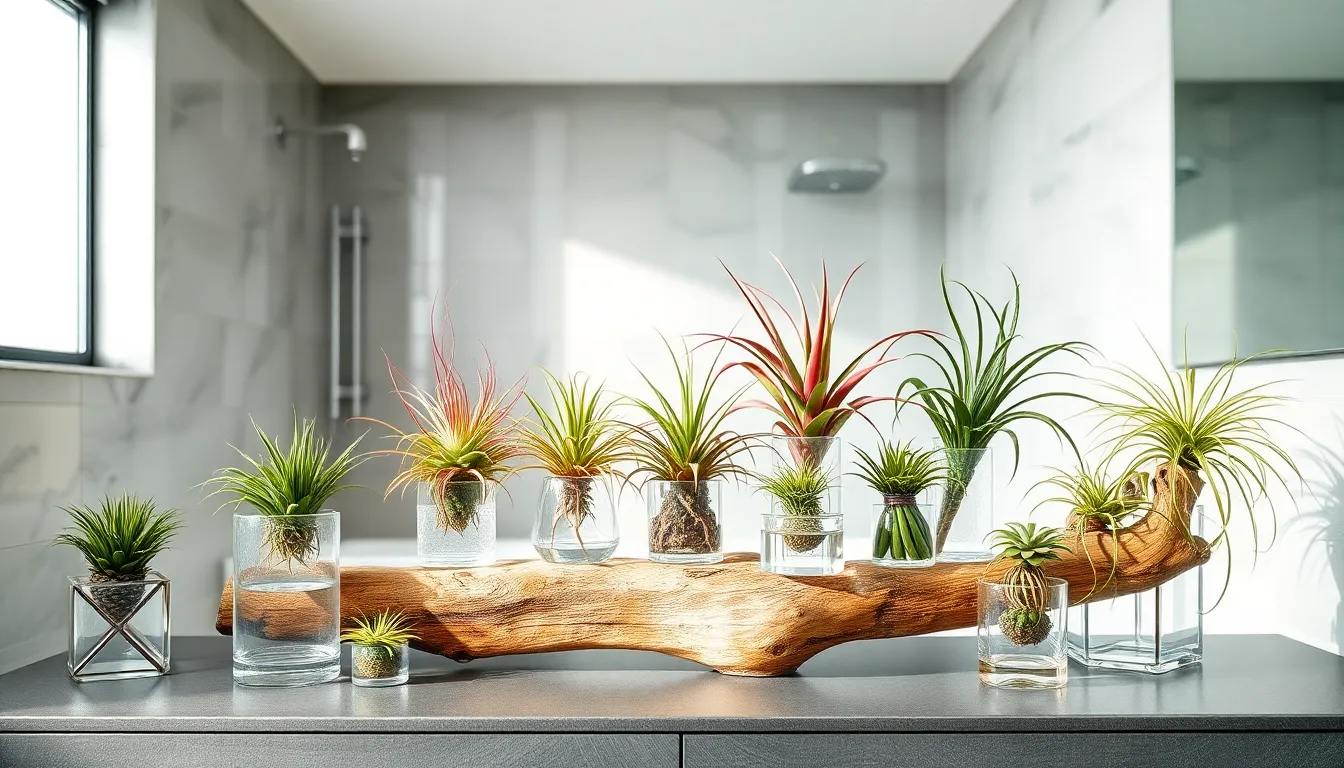
Air plants revolutionize small bathroom greenery by eliminating traditional growing constraints. These remarkable Tillandsia species offer homeowners creative freedom while maintaining the spa-like atmosphere we’ve been cultivating throughout our bathroom transformation.
No Soil Required for Easy Placement
Air plants thrive without any soil, making them perfect for mounting on walls or displaying in creative containers. We can attach these versatile plants to driftwood, cork bark, or decorative holders without worrying about mess or maintenance. Their soil-free nature allows placement in areas where traditional potted plants would be impractical, such as narrow ledges or vertical surfaces.
Mounting options include magnetic holders that stick to medicine cabinets, suction cup displays for shower walls, or simple wire frames that create floating garden effects. We can even place them directly on bathroom shelves without saucers or drainage concerns. This flexibility makes air plants ideal for renters who want greenery without permanent fixtures or holes in walls.
Absorbs Moisture Directly from Bathroom Air
Air plants naturally absorb humidity from their surroundings, making our bathroom’s steamy environment their perfect habitat. These plants collect moisture through specialized scales on their leaves called trichomes, which capture water particles from shower steam and daily humidity. We only need to provide occasional light misting rather than regular watering schedules.
Popular species like Tillandsia andreana and Tillandsia brachycaulos flourish in bathroom conditions, with the latter displaying stunning color changes from green to purple and red as it matures. Tillandsia butzii tolerates high humidity exceptionally well while maintaining its distinctive sculptural form. The consistent moisture levels in bathrooms reduce our maintenance time significantly compared to other indoor locations.
Creates Unique Decorative Displays
Air plants offer endless creative possibilities for bathroom styling, from hanging glass terrariums to geometric wire sculptures. We can create living art installations by grouping different Tillandsia species in glass orbs suspended at varying heights near windows. Wall-mounted display boards allow us to arrange multiple plants in patterns that complement our bathroom’s design aesthetic.
These plants work beautifully in modern minimalist settings, rustic farmhouse styles, or bohemian spa themes. We can change their positions seasonally or rearrange them for special occasions without replanting or soil disruption. Their architectural forms and varying textures add visual interest while improving air quality, making them both functional and decorative elements in our bathroom sanctuary.
Rubber Trees: The Bold Statement Plant for Spacious Bathrooms
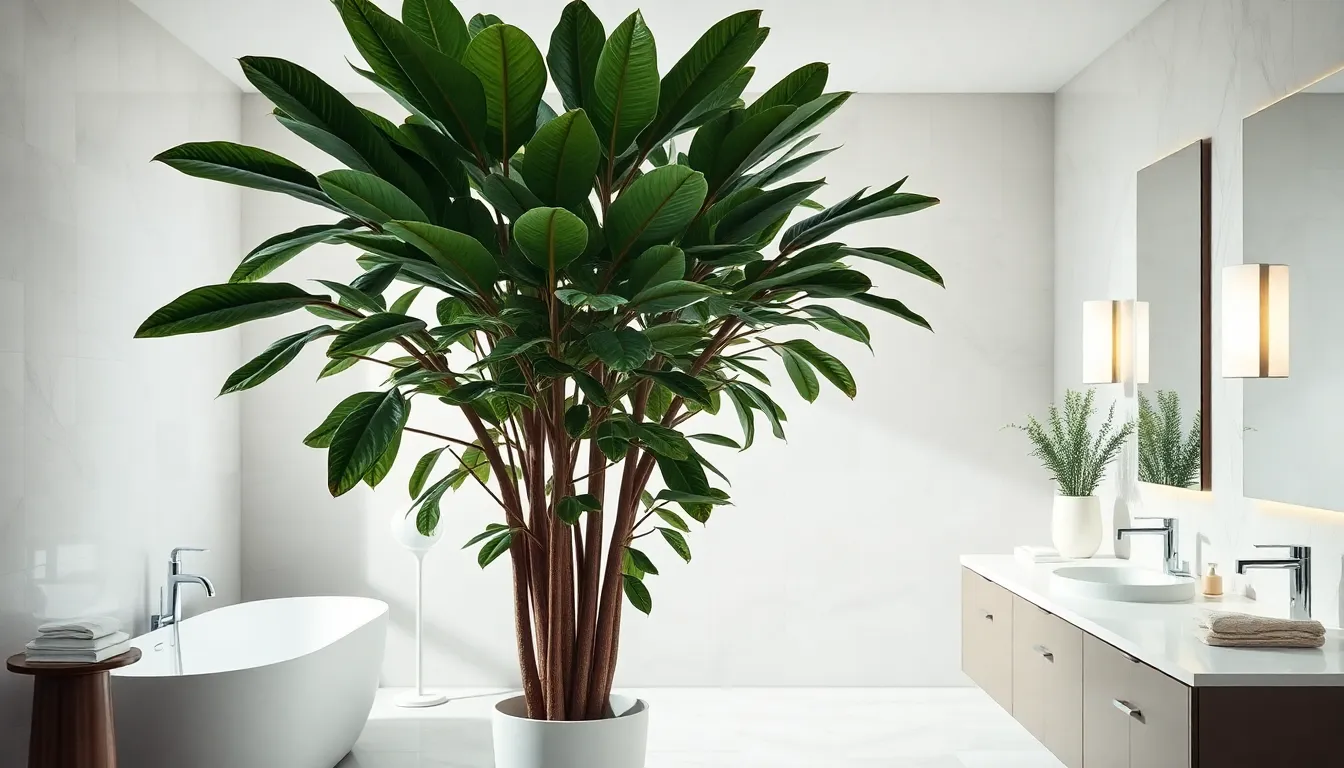
Rubber trees bring dramatic presence to larger bathrooms with their architectural form and stunning visual impact. These impressive plants transform ordinary spaces into luxurious retreats worthy of high-end spas.
Features Large Glossy Leaves
Rubber trees showcase magnificent foliage that creates instant elegance in any bathroom setting. Their leaves can reach up to 12 inches in length, displaying a rich emerald green color with a lustrous finish that reflects bathroom lighting beautifully. Each leaf features a thick, waxy texture that not only looks stunning but also helps the plant retain moisture in varying humidity levels.
The glossy surface of rubber tree leaves acts like natural mirrors, bouncing light around darker bathroom corners and creating the illusion of more space. Weekly dusting becomes essential for maintaining their brilliant shine, as dust buildup can dull their natural luster and reduce their light-reflecting properties. We recommend using a damp cloth to gently wipe each leaf, ensuring your rubber tree maintains its showstopping appearance.
Tolerates Lower Light Conditions
Rubber trees thrive remarkably well in the dimmer environments typical of most bathrooms. Unlike many large houseplants that demand bright, direct sunlight, these adaptable specimens flourish under fluorescent lighting or in rooms with small windows. Their ability to photosynthesize efficiently in reduced light makes them perfect for interior bathrooms without natural light sources.
Low light conditions actually help prevent the leaves from becoming scorched or developing brown edges, a common problem with sun-loving plants placed in humid environments. The plant’s natural adaptation to filtered light means it’ll maintain its vibrant green coloration even in basement bathrooms or powder rooms with minimal windows. We’ve found that rubber trees positioned near bathroom mirrors receive enough reflected light to support healthy growth patterns.
Grows into Impressive Floor Plants
Rubber trees develop into commanding floor specimens that anchor bathroom design schemes with their substantial presence. These plants can reach heights of 6 to 10 feet indoors, making them ideal centerpieces for spacious master bathrooms or luxury powder rooms. Their upright growth habit creates vertical interest without overwhelming smaller fixtures or cramping walking areas.
Mature rubber trees develop thick, sturdy trunks that support their expansive canopy, creating a tree-like appearance that brings outdoor tranquility indoors. The plant’s substantial root system requires large, heavy containers that provide stability for the impressive top growth, making them perfect permanent fixtures rather than easily moved decorations. We recommend placing them in corners where their broad canopy can spread freely, creating natural privacy screens between different bathroom zones while adding sophisticated botanical architecture to the space.
Conclusion
We’ve explored an incredible variety of plants that can transform your bathroom into a thriving green oasis. From low-maintenance options like snake plants and ZZ plants to dramatic statement pieces like rubber trees each choice offers unique benefits for your space.
The key to success lies in matching the right plant to your bathroom’s exact conditions and your lifestyle needs. Whether you’re dealing with low light limited space or a busy schedule there’s a perfect green companion waiting to elevate your daily routine.
Start small with one or two plants and watch as your bathroom evolves into a refreshing sanctuary that supports both your well-being and your home’s aesthetic appeal.
Frequently Asked Questions
What are the best plants for bathroom environments?
The best bathroom plants include snake plants, pothos, peace lilies, ZZ plants, spider plants, aloe vera, Boston ferns, bamboo, air plants, and rubber trees. These plants thrive in high humidity, tolerate low light conditions, and require minimal maintenance, making them perfect for bathroom environments.
How often should I water bathroom plants?
Watering frequency varies by plant type. Snake plants need water every 2-4 weeks, while ZZ plants prefer to dry out completely between waterings. Most bathroom plants benefit from the natural humidity and require less frequent watering than plants in other rooms.
Can plants really purify bathroom air?
Yes, many bathroom plants actively purify air. Peace lilies filter out formaldehyde and benzene, while most plants absorb carbon dioxide and release oxygen. The combination of natural humidity and plant transpiration creates cleaner, fresher air in your bathroom space.
Which bathroom plants are safe for pets and children?
Spider plants are completely non-toxic and safe for both pets and children. Aloe vera, while functional for healing, should be kept away from pets as it can be mildly toxic if ingested. Always research plant toxicity before introducing new plants to homes with pets or small children.
Do bathroom plants need special lighting?
Most recommended bathroom plants adapt well to low-light conditions. Snake plants, ZZ plants, and pothos thrive in dim lighting, while aloe vera prefers bright, indirect light. Boston ferns and air plants also tolerate typical bathroom lighting conditions without issues.
How do I display plants in small bathrooms?
For small bathrooms, consider air plants that don’t need soil, hanging Boston ferns to maximize vertical space, or bamboo in water-filled containers. Wall-mounted displays, windowsill arrangements, and corner placements help maximize space while adding greenery without cluttering.
What’s the easiest bathroom plant for beginners?
Snake plants are the ultimate beginner-friendly option. They tolerate neglect, thrive in low light, require watering only every 2-4 weeks, and rarely need repotting. ZZ plants are another excellent low-maintenance choice for busy homeowners or plant care beginners.
Can I propagate bathroom plants easily?
Yes, several bathroom plants are easy to propagate. Pothos can be rooted in water from cuttings, spider plants produce baby spiderettes that can be separated, and air plants can be divided. This allows you to expand your bathroom garden collection affordably.

